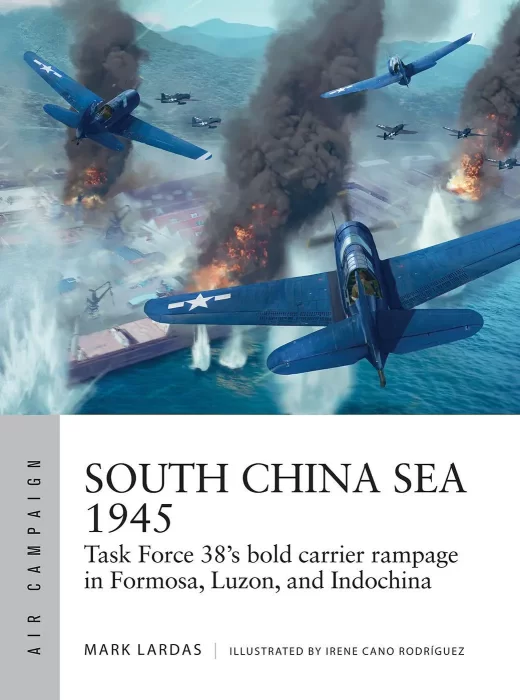South China Sea 1945: Task Force 38's bold carrier rampage in Formosa, Luzon, and Indochina (Air Campaign #36)

Date: March 16th, 2023
Сategory: History, Military
ISBN: 1472853113
Language: English
Number of pages: 96 pages
Format: EPUB
Add favorites
A history of the US Navy's remarkable 1945 South China Sea raid against the Japanese, the first time in history that a carrier fleet dared to rampage through coastal waters.
As 1945 opened, Japan was fighting defensively everywhere. As the Allies drew closer to the Home Islands, risks of Japanese air and sea attack on the US Navy carrier force increased. US forces wanted to take the island of Luzon which provided a base for Japanese aircraft from Formosa (Taiwan) and Indochina, and from where attacks could easily be devastating for the invasion fleet. US Naval Intelligence also believed Japanese battleships Ise and Hyuga were operating out of Cam Ranh Bay. A fast carrier sweep through the South China Sea was a potential answer with the bonus that it would strike the main nautical highway for cargo from Japan's conquests in Southeast Asia.
Task Force 38 would spend the better part of two weeks marauding through the South China Sea during Operation Gratitude, a month-long sweep of the area, which launched air strikes into harbors in Indochina, the Chinese coast and Formosa, while targeting shipping in the high-traffic nautical highway. By the time the Task Force exited the South China Sea, over 300,000 tons of enemy shipping and dozens of Japanese warships had been sunk. With follow-up air strikes against Japanese harbors and airfields in Formosa and the Ryukyu Islands, the success of the sweep was unprecedented.
Using detailed battlescenes, maps, bird's eye views, and diagrams of air strikes at Luzon, this intriguing account of Task Force 38's reign in the South China Sea proved that aircraft carriers could dominate the land-based air power of the fading Japanese. From the Korean War through to Vietnam, to the campaigns in Iraq, aircraft carriers could sail safely offshore, knowing their aircraft would prevail on both sea and land.
As 1945 opened, Japan was fighting defensively everywhere. As the Allies drew closer to the Home Islands, risks of Japanese air and sea attack on the US Navy carrier force increased. US forces wanted to take the island of Luzon which provided a base for Japanese aircraft from Formosa (Taiwan) and Indochina, and from where attacks could easily be devastating for the invasion fleet. US Naval Intelligence also believed Japanese battleships Ise and Hyuga were operating out of Cam Ranh Bay. A fast carrier sweep through the South China Sea was a potential answer with the bonus that it would strike the main nautical highway for cargo from Japan's conquests in Southeast Asia.
Task Force 38 would spend the better part of two weeks marauding through the South China Sea during Operation Gratitude, a month-long sweep of the area, which launched air strikes into harbors in Indochina, the Chinese coast and Formosa, while targeting shipping in the high-traffic nautical highway. By the time the Task Force exited the South China Sea, over 300,000 tons of enemy shipping and dozens of Japanese warships had been sunk. With follow-up air strikes against Japanese harbors and airfields in Formosa and the Ryukyu Islands, the success of the sweep was unprecedented.
Using detailed battlescenes, maps, bird's eye views, and diagrams of air strikes at Luzon, this intriguing account of Task Force 38's reign in the South China Sea proved that aircraft carriers could dominate the land-based air power of the fading Japanese. From the Korean War through to Vietnam, to the campaigns in Iraq, aircraft carriers could sail safely offshore, knowing their aircraft would prevail on both sea and land.
Download South China Sea 1945: Task Force 38's bold carrier rampage in Formosa, Luzon, and Indochina (Air Campaign #36)
Similar books
Information
Users of Guests are not allowed to comment this publication.
Users of Guests are not allowed to comment this publication.




